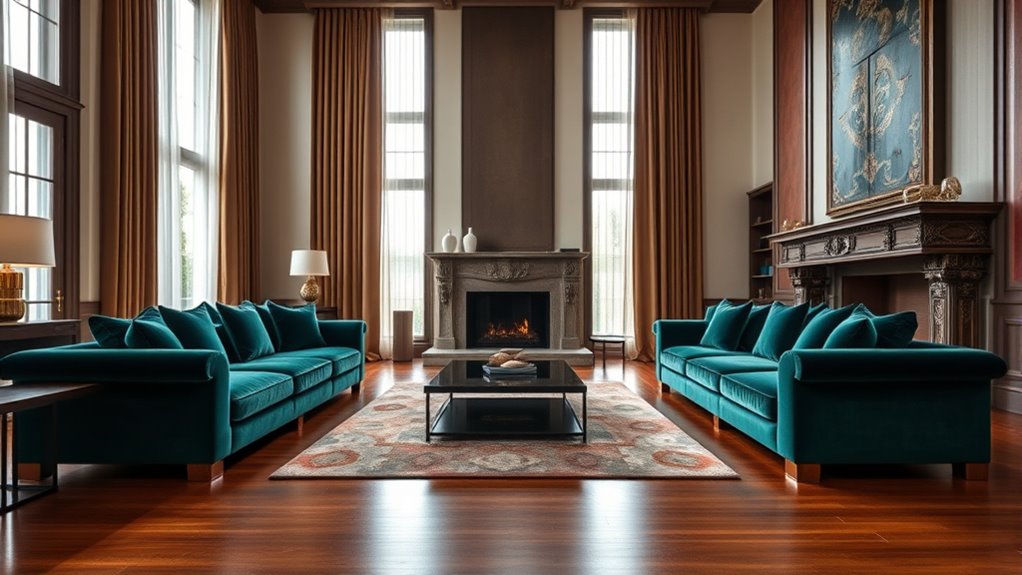To achieve the right furniture-to-room ratio, focus on scale and proportion to create balance. Measure your space carefully, including wall-to-wall distances, alcoves, windows, and ceiling height. Choose furniture that complements your room’s size—smaller pieces for tight spaces and larger ones in open areas. Keep pathways clear and styles cohesive to enhance harmony. Learning how to fine-tune these elements helps you design spaces that feel inviting and well-balanced—if you want to discover more, keep exploring these tips.
Key Takeaways
- Measure wall-to-wall distances, including alcoves, to determine appropriate furniture sizes and room proportions.
- Ensure furniture scale aligns with room size to maintain visual harmony and avoid overcrowding or under-furnishing.
- Use room-to-furniture ratios, such as 1/3 or 1/4, to create balanced and comfortable layouts.
- Consider ceiling height and window sizes when selecting furniture to ensure proper proportion and natural light flow.
- Balance larger furniture pieces with smaller accessories to achieve visual weight and cohesive room proportions.
Understanding the Basics of Scale and Proportion
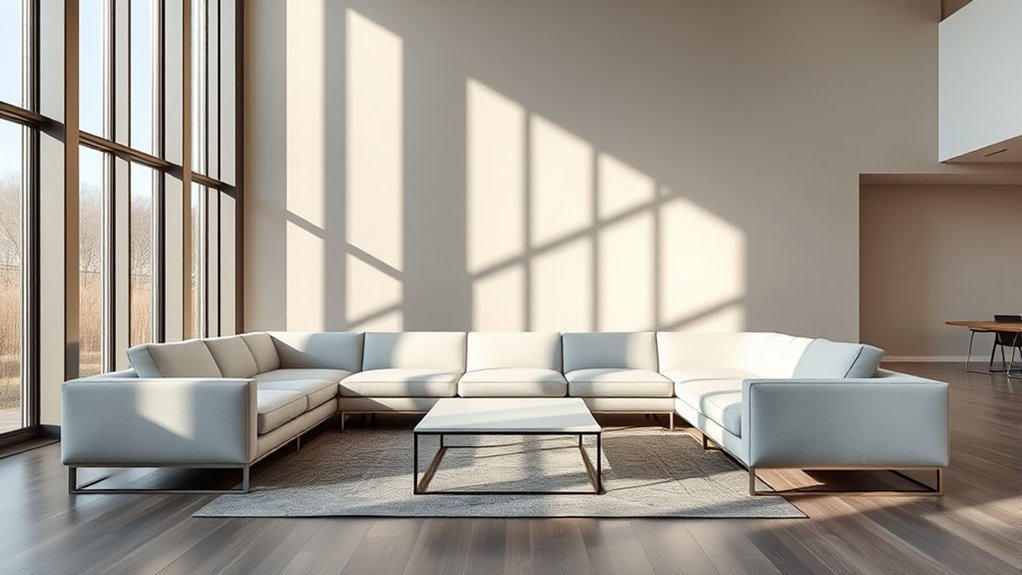
Have you ever noticed how some objects seem perfectly balanced while others feel off? That’s the magic of understanding scale and proportion. When selecting decorative accessories, size matters; a small vase can look lost on a large table, while a huge sculpture might overwhelm a compact space. Achieving harmony involves more than just picking items—it’s about how they relate to each other and the room’s dimensions. Color coordination also plays a role, tying elements together visually and creating a cohesive look. By paying attention to these basics, you ensure that each piece complements the overall design. Proper scale and proportion make your space feel intentional and inviting, rather than cluttered or sparse, guiding the eye naturally across your carefully curated environment. Additionally, understanding the room to furniture ratios can help prevent overcrowding or under-furnishing, creating a balanced and harmonious atmosphere.
Assessing Room Dimensions and Layout
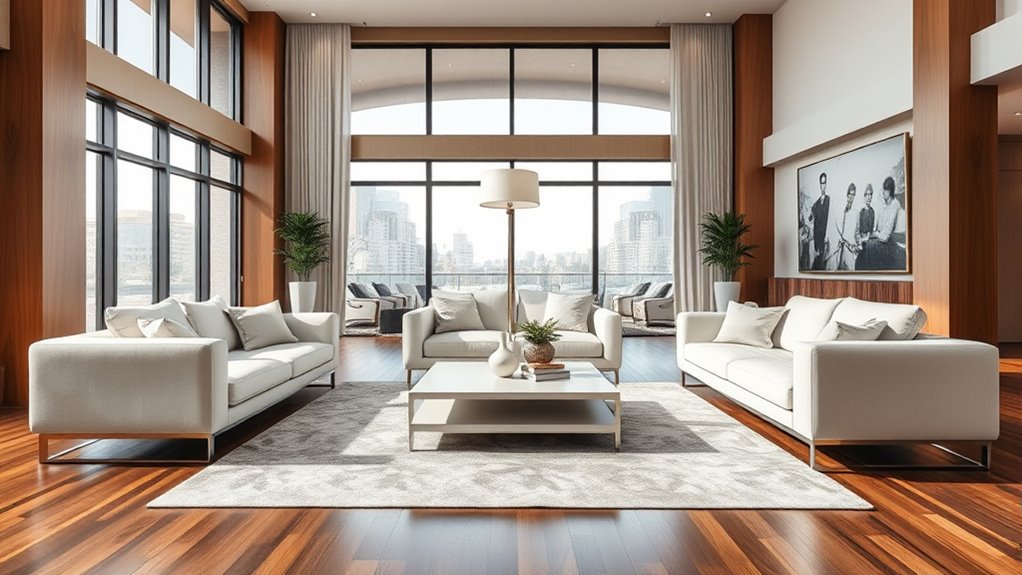
Start by measuring your room dimensions accurately to understand the space you’re working with. Next, analyze how furniture and movement will flow through the layout to optimize functionality. Don’t forget to contemplate natural lighting to enhance the room’s overall feel and balance.
Measure Room Dimensions Precisely
Accurately measuring room dimensions is essential to creating a functional and well-proportioned design. When you measure precisely, you can plan for decorative accents that enhance your space without overcrowding. To help you get started, consider these key steps: 1. Measure wall-to-wall distances, including alcoves or indentations, for accurate furniture placement. 2. Note ceiling height to ensure your furniture and lighting fit well and support proper color coordination. 3. Record window and door sizes and placements, which influence layout and the positioning of decorative accents. Additionally, understanding room proportions can help you select furniture that complements the overall space.
Analyze Space Flow Dynamics
Once you’ve gathered precise measurements of your room, the next step is to analyze how the space flows. Focus on furniture placement to ensure pathways remain clear and accessible, avoiding cluttered or obstructed areas. Consider the room’s functionality—identify zones for relaxing, working, or entertaining—and arrange furniture to support these activities seamlessly. Pay attention to how movement naturally occurs within the space, making sure each piece contributes to an intuitive flow. Avoid overcrowding by leaving enough space between furniture pieces, which enhances both comfort and usability. Additionally, understanding space flow dynamics can help in optimizing the room layout for better circulation. By evaluating these dynamics, you create a balanced environment where furniture placement promotes effortless circulation and maximizes the room’s purpose. This thoughtful approach ensures your space feels both functional and inviting.
Consider Natural Lighting Factors
Understanding your room’s dimensions and layout is essential for evaluating natural lighting. Sunlight patterns and window placement greatly influence how light fills your space. To optimize this, consider these factors:
- Observe sunlight movement throughout the day to identify the most illuminated areas.
- Assess window sizes and positioning to maximize light entry while minimizing glare.
- Plan furniture placement to enhance natural light, avoiding blocking key windows and allowing sunlight to reach deeper into the room.
- Incorporate vertical storage solutions to free up space and prevent clutter that could obstruct light flow.
Selecting Furniture Sizes for Small Spaces

When choosing furniture for small spaces, focus on maximizing space efficiency by selecting pieces that serve multiple functions. Opt for compact furniture that fits comfortably without overwhelming the room, and keep visual balance in mind to avoid clutter. Balancing size and proportion guarantees your space feels open and inviting rather than cramped. Incorporating furniture with appropriate scale and proportion ensures harmony between the room size and the furnishings.
Prioritize Space Efficiency
How can you make the most of limited space? Prioritizing space efficiency is key. Choose furniture that fits your decorating style without overwhelming the room. Opt for pieces that serve multiple purposes, like a sofa bed or storage ottoman, to maximize functionality. Keep your color schemes light and cohesive to make the space feel larger. When selecting furniture sizes, consider these tips:
- Use scaled-down pieces that match the room’s proportions, avoiding bulky items.
- Select furniture with slender legs or open frames to create a sense of openness.
- Focus on versatile furniture that complements your decorating styles, ensuring practicality without sacrificing style.
- Incorporate self-watering plant pots to add greenery without taking up extra space, enhancing the room’s ambiance while maintaining a clean and uncluttered look.
Opt for Compact Pieces
Choosing compact furniture is essential when working with limited space, as it helps prevent your room from feeling crowded. Select pieces that suit your decorating style while maintaining practicality. For example, sleek, multi-functional furniture works well in modern or minimalist designs, while streamlined wooden pieces complement Scandinavian styles. Consider furniture materials that are lightweight yet sturdy, like metal frames or thin-profile wood, to keep the room feeling open. Avoid bulky, oversized items that dominate the space. Instead, opt for scaled-down versions of essential pieces like sofas, tables, and beds. This approach maximizes functionality without sacrificing style, ensuring your small room remains comfortable and visually balanced. Remember, the goal is to create a cohesive look with furniture that fits perfectly within your space.
Maintain Visual Balance
Ever wonder how to make a small space feel balanced and inviting? Maintaining visual balance is key. First, choose furniture that complements your decor style without overwhelming the room. Second, stick to a cohesive color scheme; lighter shades can make the space appear larger, while bold accents add interest without clutter. Third, consider the proportions of each piece—avoid oversized furniture that dominates and opt for streamlined, appropriately scaled items. Position furniture thoughtfully to create a natural flow, leaving enough space for movement. By aligning your furniture sizes with your decor style and color schemes, you’ll craft a harmonious environment that feels both comfortable and well-balanced. Remember, less is often more in small spaces—balance your furniture to maximize visual harmony. Additionally, understanding the scale & proportion of furniture relative to the room can significantly influence how spacious or cozy the area feels.
Choosing Larger Pieces for Spacious Areas

When decorating spacious areas, opting for larger pieces can create a sense of harmony and balance. Larger furniture commands attention and establishes a strong visual anchor in the room. Choose pieces that reflect your artistic expression, showcasing unique shapes or bold designs that enhance the space’s character. Material textures also play a pivotal role; incorporating varied textures like wood, metal, or fabric adds depth and interest. Larger furniture should complement the room’s proportions without overwhelming it, so consider scale carefully. By selecting substantial pieces thoughtfully, you emphasize the room’s openness while maintaining visual cohesion. Additionally, understanding scale and proportion helps ensure that furniture fits harmoniously within the space, preventing it from appearing cluttered or sparse. This approach allows you to craft a space that feels both inviting and well-curated, making the most of the room’s spaciousness without sacrificing style or comfort.
Balancing Furniture and Open Space

How do you guarantee your furniture enhances rather than overwhelms a spacious room? The key is balancing furniture with open space while allowing room for artistic expression and furniture customization. Incorporating design principles can further optimize the room’s proportions and aesthetic balance. 1. Choose scaled-down pieces or multi-functional furniture that fit the room’s proportions without crowding. 2. Use open layouts to create visual breathing room, making sure furniture placement emphasizes flow and purpose. 3. Incorporate personal touches through furniture customization—like unique finishes or modular options—that reflect your style without clutter.
Using Visual Weight to Create Harmony

Have you noticed how some rooms feel balanced and harmonious while others seem off-kilter? That’s often due to how visual weight is distributed within the space. Visual weight refers to how much a piece of furniture or decor draws your eye and commands attention. To create harmony, balance these visual weights so no single element overwhelms the room. Larger, darker, or more detailed objects carry more visual weight, so place them thoughtfully. Balance a heavy piece with lighter or smaller items elsewhere to maintain equilibrium. Consistent visual weight across different areas helps your room feel cohesive and inviting. By understanding and manipulating visual weight, you guide the eye naturally, creating a space that feels unified and harmonious. Additionally, applying principles from financial management such as budgeting your design elements can help maintain proportion and balance effectively.
Tips for Arranging Furniture Effectively
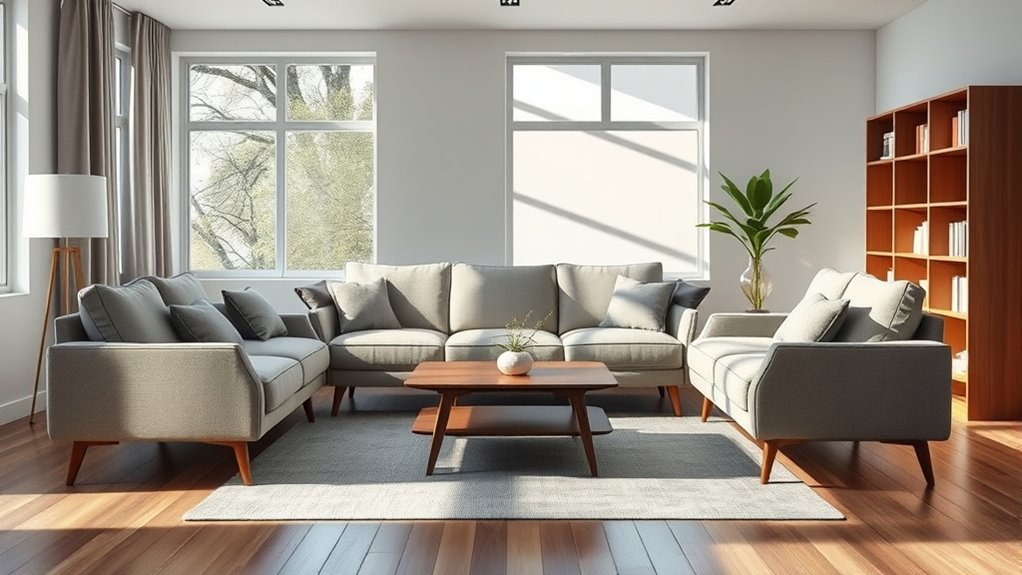
Effective furniture arrangement starts with understanding the function of each space and how you move through it. To maximize flow, consider the room’s focal point and arrange furniture accordingly. Next, focus on balance and scale, ensuring pieces aren’t too large or small for the room. Here are some tips:
- Use decorative accessories to add personality without clutter, maintaining visual harmony.
- Coordinate colors across furniture and accessories to create a cohesive look that feels inviting.
- Leave enough space between furniture pieces for easy movement, preventing overcrowding.
- Keep in mind the proportion of furniture to the room size to ensure a comfortable and functional layout.
Common Mistakes to Avoid in Room Scaling
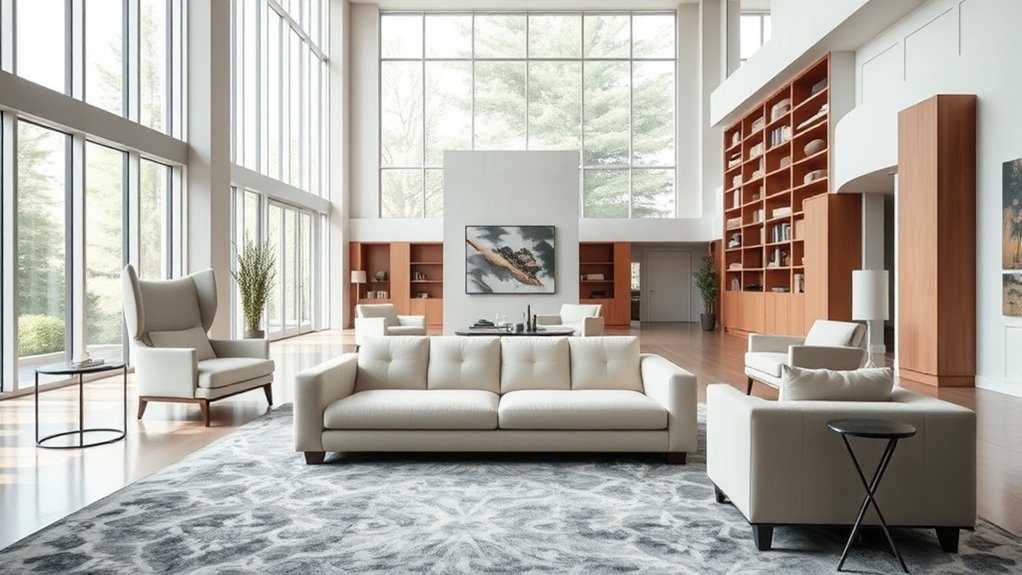
One common mistake in room scaling is choosing furniture that’s either too large or too small for the space, which can disrupt the room’s balance and flow. This often results from misjudged scale, where pieces don’t match the room’s proportions. Mismatched proportions make a space feel awkward or cramped, instead of harmonious. To avoid this, measure your room carefully and consider the size of each piece relative to the space. Overly bulky furniture can overwhelm a small room, while tiny furniture in a large room can feel insignificant. Pay attention to the visual weight of furnishings and how they relate to the room’s dimensions. Proper scale guarantees a balanced, inviting environment—so steer clear of mismatched proportions that throw off the room’s harmony. Additionally, understanding contrast ratio and its impact on visual clarity can help in selecting furnishings that complement your viewing setup, ensuring a cohesive aesthetic.
Practical Examples of Well-Proportioned Rooms
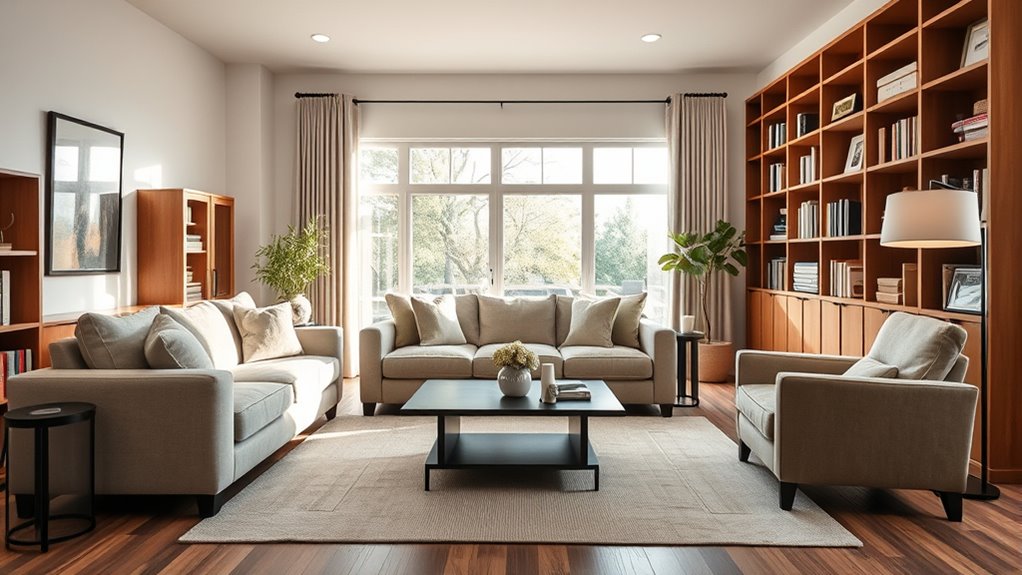
A well-proportioned room balances furniture sizes with the space available, creating a comfortable and cohesive environment. Practical examples show how thoughtful arrangements enhance decorating styles and color coordination. Additionally, considering the relationship dynamics between furniture pieces can foster a more inviting atmosphere.
Frequently Asked Questions
How Does Ceiling Height Affect Furniture Scale Choices?
When ceiling height increases, you should choose larger furniture to maintain proper furniture proportion and avoid a cramped feeling. Taller ceilings make spaces feel more open, so you can select oversized pieces or taller furniture to fill the room appropriately. Conversely, if ceilings are lower, opt for smaller, more streamlined furniture to prevent the space from feeling overwhelmed. Always consider ceiling height to create a balanced, comfortable environment.
Can Unconventional Furniture Shapes Influence Room Balance?
Sure, unconventional shapes can totally save the day—if you enjoy chaos disguised as design. These daring pieces might turn your room into a visual rollercoaster, challenging room harmony instead of supporting it. But if you’re brave enough to balance these bold shapes with simpler elements, you’ll create a stunning, eclectic space. Just remember, in the world of unconventional furniture, harmony is more about daring than matchy-matchy.
How Do Architectural Features Impact Furniture Proportion Decisions?
Architectural features like wall textures and lighting effects heavily influence your furniture proportion choices. You’ll want to select pieces that complement textured walls, avoiding overwhelm or underwhelming effects, and guarantee lighting enhances furniture visibility and ambiance. By considering these elements, you create a harmonious balance where furniture size feels natural within the space, emphasizing architectural details without overpowering or being overshadowed, resulting in a cohesive and inviting room.
What Role Do Color and Pattern Play in Perceived Scale?
Colors and patterns can dramatically transform how you perceive scale in a room, almost like a magic wand altering size perceptions. Bright, bold colors evoke energy and make objects feel larger, while softer hues create calm, reducing perceived size. Pattern dynamics, such as large or intricate designs, can emphasize or diminish scale. By understanding color psychology and pattern effects, you can manipulate a space’s feel, making furniture appear perfectly proportioned or intentionally oversized for dramatic impact.
How Can I Adapt Furniture Scale for Multi-Use Spaces?
To adapt furniture scale for multi-use spaces, choose multifunctional furniture that can easily switch functions, like fold-out beds or extendable tables. Opt for a flexible layout that allows you to rearrange pieces as needed, creating open areas for socializing or private zones for work. Keep proportions balanced, avoiding oversized furniture that overwhelms the space, ensuring the room remains comfortable and versatile for different activities.
Conclusion
Remember, achieving perfect scale and proportion is like tuning a symphony—you want every piece to complement the whole. When your furniture fits your space like a well-fitted suit, your room feels harmonious and inviting. Pay attention to balance and visual weight, and don’t be afraid to experiment. With a keen eye and thoughtful choices, you’ll craft a room that sings with style and comfort—an orchestra of design that truly feels just right.

